Workplace Values: The Effect on Job Performance and Commitment
Info: 7882 words (32 pages) Dissertation
Published: 6th Sep 2021
Tagged: EmploymentManagement
Table of Contents
Result 1: Alignment of Values within the Workplace
Result 3: Commitment to the Company
Analysis 1: Alignment of Values within the Workplace
Analysis 3: Commitment to the Company
Recommendation 1: Alignment of Values within the Workplace
Recommendation 2: Workplace Culture
Recommendation 3: Commitment to the Company
Table of Figures
Figure 1 – Discussion of Values
Figure 2 – Importance of Company Values
Figure 3 – Supervisor Feedback
Figure 4 – Company Commitment: Monetary Value
Figure 5 – Company Commitment: Moral or Ethical Reasons
Figure 6 – Motivation to Work at Teck Coal Ltd.
Introduction
This study focuses on the values set in place by Teck Coal Ltd. and how their employees being connected to these values it leads to more productive workplace. Teck Coal Ltd. has six values that they use to guide their decisions in day to day work. These values are: sustainability, safety, integrity, respect, excellence, and courage (Teck Resources Limited, 2015). To understand how these values influence the culture and work environment within Teck Coal Ltd., a survey was administered to employees at the Fording River Operation of Teck Coal.
Teck Coal Ltd. (Teck Coal) is a metallurgical, open-pit, coal mining company based out of Western Canada. Teck Coal has five mines in the Elk Valley, which is located in the southeast corner of British Columbia by the town of Fernie. This study surveyed employees from the largest of the five mines in the valley, Fording River Operations (FRO). The coal produced at FRO is shipped by rail to Vancouver and then primarily sent overseas to China and other countries in Asia to be used in the steel-making process.
FRO has over 1000 employees working on-site with approximately 200 staff employees, the rest being hourly employees. The staff employees were the focus of this survey to determine the level of alignment between their personal values and the company values. Staff employees work in all departments on-site: operations, maintenance, processing, and support. Providing Teck Coal-FRO with a general understanding of how their employees’ values match the company’s and what aspects need improvement can assist the company with increasing the level of satisfaction and engagement experienced by their employees.
Literature Review
It has been observed that important stakeholders, including employees, supervisors, and sometimes key management personnel, in general, are unaware or only partially aware of their own organization’s values (Somers & Birnbaum, 1998). It is important that these stakeholders not only know, but also believe in their organization’s values. Studies have shown that when the individuals’ values align with the organization’s values, the individuals working in the organization not only have greater levels of job performance than those who don’t, but also stay longer in their tenure with the company (Somers & Birnbaum, 1998).
The influence of supervision on the employees’ behaviour can affect their values. When managers are abusive, the instances of Social Dominance Orientation (SDO) increase. SDO leads to deviance and reduction in interpersonal citizenship (Shao, Resick, & Hargis, 2011). This means that when managers are abusive, the subordinates develop this behavior and their interactions with each other become less civil and more hostile. On the other hand, psychological collectivism (PC) when practised by supervision promotes interpersonal citizenship. (Shao, Resick, & Hargis, 2011)
Characteristics of the person and their interactions on the job are used to determine such things as job choice, satisfaction and employee well-being (Edwards & Newell, 1994). Examining the broader notion that the congruency between characteristics of the individual and characteristics of the organization itself can have significant impacts on attitudes and behaviour (Chatman, 1989) & (Ravlin & Meglino, 1987). Employees with clashing values from their organization were found to “shrink” in terms of job performance. This leads to outcomes which will neither be fruitful for the organization nor the individual. The measure to which this de-alignment is affected was varying based on different individuals. It was also found that organizational commitment increased if the employee stayed in the organization for a longer period and if there was a match between the personal values and organizational values from the start of the employee’s recruitment with the company (Caldwell, O’Reilly, & Schmitt, 1990). The concept of personal perspective weighed in more often than the collective judgements when it came to organizational values (Cable & Judge, 1997). For example, even if an organization is truly moral, but the individual perceives that it is not, the individual’s behaviour will be guided by his or her perception of immorality and not by what is the case. Therefore, the relationship between person–organization affective commitment might be stronger when the values of the organization are measured from the individual’s perspective rather than using collective judgments. With all three types of commitment (affective, normative, and continuance), the employee is ‘committed’ to the organization but for different reasons, and accordingly, each type of commitment produces different effects. Affective commitment is associated with higher productivity (Meyer, Sampo, Gellatly, Goffin, & Jackson, 1989), more positive work attitudes (Meyer & Allen, 1996), and a greater likelihood of engaging in organizational citizenship (Meyer & Allen, 1991). Thus, the positive feelings, which affectively committed individuals have towards their organization, are accompanied by other beneficial effects for the organization. Similar findings emerge for normative commitment (Meyer & Allen, 1997). In contrast, continuance commitment has very few positive relations with performance indicators (Meyer & Allen, 1997). Individuals who score high on continuance commitment stay at their job because they have few alternatives, therefore, it is not surprising that continuance commitment is negatively (albeit modestly) correlated with job satisfaction (Hackett, Bycio, & Hausdorf, 1994) & (Moorman, Niehoff, & Dennis, 1993). Indeed, it appears that the only similarity between affective commitment and continuance commitment is that each is associated with lower turnover. Perhaps people who value diligence are more likely to feel committed to an organization because of feelings of obligation (i.e. normative commitment). Indeed, there is research which suggests that values alone can influence attitudes and behaviour. Personal values have been shown to influence both corporate strategic decisions (Guth & Tagiuri, 1965), and managerial decisions (England, 1975). One can imagine a situation where employees might feel more committed to the organization if the organization was not seen to embrace certain values in their extreme. For example, the value of Excellence, at one extreme might be thought of as stinginess to perfection and at the other extreme as just for displaying it for the industry. Employees might be more committed to an organization that is seen to strike a balance between these two extremes. Rather than treating values as a large, single continuum, it is important to realize that different values or clusters of values may have different effects on commitment.
The more the organization is perceived as operating by the values embodied in the humanity factor (courtesy, consideration, cooperating, fairness, forgiveness and moral integrity) and the vision factor (development, initiative, creativity and openness), the greater the affective commitment of the employees. This meant that the greater the humanity values were perceived to be the organizational values, the more affectively committed the employees were to the organization. Finally, none of the measures based on values relating to the financial bottom-line significantly predicted affective commitment. (Finegan, 2000)
Organizational commitment has been tested to closely test for tenure and turnover intention based on perceived and personal organizational values (Abott, White, & Charles, 2005). Although affective and normative commitment is linked to perceived values, continuance organization commitment is not. This means that organizational values do not influence employees whose commitment is based on continuance. This is mainly displayed with seasoned employees who may have motives other than company values to stay. When it comes to turnover intention, employees are attracted to companies with visions values. These same companies, through affective commitment of their workers managed to reduce turnover (Abott, White, & Charles, 2005).
A case in point of vision in values and workforce satisfaction was that of Levi Strauss (Howard, 2000). In an interview with their CEO, Robert Haas, the link between values, workforce satisfaction, and business success was found to be one and the same thing. This amalgamation is greatly due to globalization and the different values and principles that the new generation of workers have, compared to their predecessors. To keep up with the changes, taking a more socially responsible stance through stated values is the natural next step. This resulted in more employee participation and diffusion of power and authority. The frontline workers became more committed to the company’s success and provided crucial feedback to management. Business strategy became more in tune with the realities of the market, and managerial decisions were better followed. Levi Strauss was a pioneer in this approach and its effects were felt up and down their supply chain. Their clients and retailers followed suit in developing socially responsible values that were pushed for equally by the end consumers. This is especially true in the apparel market where concerns over sweatshops and child labor remain an ongoing social problem (Howard, 2000).
The exercise of preparing a values statement should not be a simple task on a to do list. Significant effort should be spent in identifying what truly are the values in an organization. Words like “Ethical”, “Teamwork, “Authentic”, “Fun” and “Consumer oriented” should be avoided at all cost (Yohn, 2018) . Such terms are ambiguous, mainstream and generic at best. In developing a values policy and statement, the organization should consider what truly makes them unique. For instance, fast food restaurants are all committed to providing food for the customers fast, so one company can not make that a value. They should investigate how this service is achieved that stands out from others (Yohn, 2018). Similarly, this can be said of other industries. A comprehensive values policy requires time, group effort and iterations until a final version is agreed on and declared. One can even say that the process of developing a values statement would promote said values especially if all members of the organization participate in it.
Congruency of values or the fit between person and organization is an indicator of a worker’s satisfactions and commitment. It has long been thought, rather erroneously, that demographic parameters such as age, gender or ethnicity is related to the congruency of values. In fact, in Canada, in many provinces, minimum wage is lower for workers aged less an 18. This is mainly thought by the public that it reflects that younger workers may not be as committed or reliable. Or that younger workers do not have the same needs, and by default, have different values. Posner proved through a study of over 1600 workers in a multinational organization that all demographic traits are unrelated to congruency (Posner, 1992). It is rather the attitudes displayed in the workplace, by management, that drive the person-organization fit. This again emphasizes the need to enact values that are unique, progressive and socially responsible so that the workforce commits to them and promotes them.
Method
All the information used for this report was gathered through a software called Google Forms. Initially, Teck Coal-FRO was contacted to gauge what important organizational behavior issue the corporation wanted our group to consider in the study. It was determined by the corporation that the group would conduct research on the corporation’s values and the alignment of those values with the personal values of their employees.
Once the topic was determined, our group constructed survey questions surrounding the corporation’s values and whether the employees were aware of them and agreed with them. There were also questions about whether the corporation’s values play a role in management decision making and how visible the corporation’s values are in everyday interactions within the company. We included questions about commitment to work to discover if there were any trends between alignment of personal and work values and affective organizational commitment. Finally, we also phrased indirect questions at the end of the survey to truly test whether the employees’ personal values aligned with those of the corporation.
The survey also asked personal questions like age, gender, number of years spent employed with the company, and education level to see any patterns or effects of these demographics on the survey results. There were 31 questions in total with a range of options to be selected from by the respondents.
Once the survey questions were finalized, the Google Forms survey was sent via email to a team of approximately 42 people at FRO by the Human Resources Department within FRO. The HR department chose the group of staff employees to send the survey including all age groups and seniority levels at the corporation to gather a wide range of data. The employees were given two weeks to submit their responses.
Our group chose to send out an online survey instead of conducting in person interviews because we determined this would be the most efficient and effective method of gathering such a large quantity of data with the least amount of disruption to the employees, thereby encouraging them to participate. FRO in also located in southeast British Columbia, therefore the online survey was the most practical method of collecting the data.
The data received from the Google Forms survey results was easily exported into a Microsoft Excel format for interpretation by our team.
Results
Our survey results came from Teck Coal-FRO employees between the age range of 26-55+ and most of the respondents have worked for the company for at least 8 years. Of the 20 results, only 1 person had worked for the company for less than 1 year and 70% came from male employees.
Result 1: Alignment of Values within the Workplace
The respondents of our survey fell under three job level categories, Individual Contributor, Supervisor, and Manager/Senior Management. To determine the level of compatibility between personal and company values the survey asked several questions about the six values individually, and as a group. When asked “How often are values discussed at Teck?” (Refer to Figure 1 – Discussion of Values) the results varied depending on the job title the respondent had. Only individual contributors who had been with the company for 1-7 years answered “Never”. Most individual contributors who had been with the company for between 1 and 12 years answered “Occasionally”, and only one individual contributor who has been with the organization for 8-12 years answered “Often”. Additionally, we found that no respondents who held a Supervisor position responded with “Never” and most of the Supervisors who have been with the organization for 8-13+ years responded with “Occasionally”. Two Supervisors that have been with the organization for 8-12 years responded “Often”. Finally, we found most of the Managers/Senior Management who have been with the organization for 13+ years responded with “Often”, while only three Managers/Senior Management who have been with the organization for 8-13+ responded with “Occasionally”. When asked if Teck Coal’s Values affect decision-making, 70% of respondents said that they believe the values did in fact affect decision making either consistently or somewhat consistently while 30% answered that the values have little impact on decisions made at Teck Coal-FRO.
Of the six company values, the majority of respondents believed all of them were very important to them personally but did not believe that Teck found Integrity, Respect or Courage as important to the company (Refer to Figure 2 – Importance of Company Values). The response for the value Safety also varied, as 100% of respondents found it to be very important to them personally but only 75% believed it was very important to the company. Although, 65% of respondents answered that Safety in the most visible and discussed value at Teck Coal-FRO.
Result 2: Workplace Culture
To determine the culture and support received by employees at Teck Coal from their supervisors, the question “Management provides timely and constructive feedback about my performance” (Refer to Figure 3 – Supervisor Feedback) was asked. All the Individual Contributors answered varying from strongly disagree to somewhat agree, while supervisors ranged from somewhat agree to strongly agree. It was noted that in general, individual contributors who have spent the least amount of time with the company as compared to Supervisors and Managers/Senior Management were more likely to respond with either strongly or somewhat disagree.
When asked if “my manager is considerate and supportive”, 95% of the respondents answered that their supervisor is either relatively or very considerate and supportive. Similarly, when asked “how respectful are the leaders at Teck Coal of their employees when values are questioned?”, 95% also responded that the company leaders are respectful or extremely respectful when values are questioned.
Result 3: Commitment to the Company
To evaluate the level and type of commitment to Teck Coal, several questions were asked to determine if employees showed affective, normative, or continuance commitment. One of the key results collected was in response to the question, “Is your perceived economic value of remaining with the company enough to keep you committed to Teck Coal?” (Refer to Figure 4 – Company Commitment: Monetary Value). A mixture of yes and no were received with the majority (80%) responding yes, that a perceived economic value was enough of a motivator to keep them committed to the company. Additionally, respondents were asked, “Do you feel obligated to stay with Teck Coal for moral or ethical reasons?” (Refer to Figure 5 – Company Commitment: Moral or Ethical Reasons). We received a mixed response of yes and no to this question, with 60% responding no. Finally, respondents were asked, “What motivates you to work at Teck Coal?” (Refer to Figure 6 – Motivations to Work at Teck Coal Ltd.). There were four options available to choose from: 1. I feel connected to the company’s values and feel Teck Coal contributes to the society 2. It allows me to pay the bills. 3. I hold a key position and feel obligated to remain with the company, and 4. The company has been loyal to me and has helped me grow personally and professionally. Of the results, 90% answered that they feel connected to the company values and feel Teck Coal contributes to the society or the company has been loyal to them and has helped them grow personally and professionally.
Discussion and Analysis
Analysis 1: Alignment of Values within the Workplace
An apparent trend observed is that the respondents who have been with the company the longest are the ones that hold Manager/Senior Management roles. Similarly, most Supervisors followed having spent 8-12 years with the company, and most Individual Contributors held 1-7 years. A strong correlation was found that 55% the Supervisors, Managers, and Senior Management responded that Teck Coal’s values were often discussed either in meetings or with colleagues and 45% said they were occasionally discussed. Conversely, 89% Individual Contributors responded that values were either never or only occasionally discussed. From this information, it is concluded that the higher up the ranks, and the longer amount of time spent with the company, respondents seem to be more aware of Teck Coal’s values and discuss them more frequently. To further analyze this finding, a study has shown that the longer tenured employees had personal and professional values that were aligned with the organization’s values (Somers & Birnbaum, 1998). The study found that this alignment of personal and organizational values resulted not only in employees experiencing greater job satisfaction and engagement, but also causing the employees to feel deeper rooted and comfortable in their positions within the organization over time. As such, many of these employees with aligned values remained high performers and committed to the organization. Finally, ensuring feedback and psychological collectivism is key in aligning personal and company values (Shao, Resick, & Hargis, 2011). The importance of Teck Coal’s values was based on how important the values are to the repondent personally and then how important they believed the values were to Teck Coal. To the repondents personally, all six of Teck Coal’s values were found to be very important to at least 70% of the people surveyed, which shows significant alignment between the company values and their employees. When asked how important they felt these values were to Teck Coal the results were significantly lower with only 40% – 70% of the responses showing that the values are very important to Teck Coal. This variation could result from the fact that only 60% of respondents felt that the values are discussed often and therefore there is not enough emphaises or focus placed on the values in day to day work. 30% of employees who participated in the survey did not feel that the values were present, or were lacking in Teck Coal’s decision-making process.
Analysis 2: Workplace Culture
From the results, Teck Coal has created an open and supportive environment to work. 95% of respondents answered that their supervisors are considerate and are open to discussions when values are being questioned. At the Individual Contributor level, over 50% of the respondents do not feel there is enough feedback provided to them about their performance. By increasing this feedback and ensuring people feel valued by the company, the level of job satisfaction is increased. When job satisfaction is increased employees perform better and are more productive at work (Langton, Robbins, & Judge, 2016).
Analysis 3: Commitment to the Company
There are a variety of reasons why an employee may wish to remain committed to a company. First, an employee can identify with affective commitment. In this scenario there is an emotional attachment to an organization and a belief in its values (Meyer, Sampo, Gellatly, Goffin, & Jackson, 1989). Based on the responses, 35% of the respondents feel connected to the company’s values and feel Teck Coal contributes to society. It can be inferred that these respondents possess a certain level of affective commitment to the company. In contrast, normative commitment to an organization is characterized by an individual who feels obligated to remain with an organization for moral and ethical reasons (Meyer & Allen, 1997). Our survey results show that when a question was asked about “what motivates you to work at Teck Coal”, 55% of respondents feel a level of normative commitment to the company because they have been loyal to them and helped the respondent grow. When the question is asked in the way of if the respondent stays with the company for moral or ethical reasons 60% say that they do not. Finally, we assessed continuance commitment, which is an individual’s perceived economic value of remaining with an organization (Hackett, Bycio, & Hausdorf, 1994) & (Moorman, Niehoff, & Dennis, 1993). We see that 80% of the respondents responded favourably to our question gauging continuance commitment.
The responses we received regarding Teck Coals organizational commitment show commitment based mostly on an affective and continuance variety. This is an important factor to consider as studies have shown that different forms of organizational commitment have effects on behaviour and performance in the workplace (Meyer & Allen, 1991). Those with an affective commitment tend to exhibit stronger organizational performance than those with a normative or continuance commitment style. Conversely, those with continuance commitment, approximately up to 80% of survey respondents, depending on how the question was asked, exhibit correlations with a lower intention to quit, but higher absenteeism and poor job performance (Hackett, Bycio, & Hausdorf, 1994) & (Moorman, Niehoff, & Dennis, 1993). According to our survey, most of the respondents have been with the company for at least 8 years.
Recommendations
Recommendation 1: Alignment of Values within the Workplace
From our sample pool of respondents at Teck Coal, it is recommended that Teck Coal should focus on ensuring company values are transparent to all levels of the organization, primarily to the individual contributors. To improve transparency with newer employees and build organizational alignment, Teck Coal’s communication of values must be more frequent and two-way at all levels, using multiple communication vehicles and a variety of targeted messages. One way this can be done is by linking work activities that seem to lack strategic effort back to the organization’s values and strategy (Guth & Tagiuri, 1965). Increasing this transparency and focus on company values will promote consideration of all their values in day to day decision-making. It will also help to strengthen the correlation between the perceived importance of the values to the company and how important each value is to the employees. 65% of the respondents answered that Safety was more discussed and one of the most visible values, so Teck Coal should work on promoting and discussing the other values as much as Safety.
Recommendation 2: Workplace Culture
Teck Coal should promote casual performance conversations between employees and their supervisors to help move business forward but also as a method to increase communication about company values and these values can be used to help in decision making. It would also be beneficial to introduce a more casual form of measurement and feedback system, from Teck Coal’s current feedback system, to identify and build on what is workingvwell, and adjust actions that do not have a desired impact. All actions that improve value transparency and further align employee and company values will ultimately create stronger and more committed employees unique to Teck Coal.
Recommendation 3: Commitment to the Company
We see that Teck Coal has a group of employees that have been committed to the organization for several years, but this does not indicate high performance or a commitment to the company’s values and social corporate responsibilities (Hemmingway & Maclagan, 2004). Moving forward, Teck Coal can engage in a variety of activities to ensure their continuously committed employees are improving their job performance. We recommend Teck Coal organize an annual or semi-annual event that supports improving on existing skill sets or building completely new ones. A suggestion could be a lunch and learn targeted to improve communication or improve leadership skills. Additionally, Teck Coal could encourage broader industry continuing education by developing a program or start a score system where a certain number of credits go towards fulfilling a continuing education requirement mandated by the company. As well, nurturing the affectively committed employees can also achieve positive results. We would recommend hosting an annual award ceremony to recognize high performers and encourage intrinsic motivation, so these employees can continue to achieve more for themselves and the company.
Limitations
Some limitations to this study include the means in which the data was collected. By providing a convenient answer selection it allowed for the survey to be completed in a quick and streamlined way but eliminated the opportunity for employees to expand on certain ideas or to identify concepts not covered in the standardized answer format. Some employees may have also encountered boredom due to the repetitiveness of the questions when responding and may have just clicked random answers without reading the question in order to complete the survey as fast as possible.
The number of responses we received was also a limiting factor, as we would have preferred to gather data from a broader range of employees (at least 120 individuals or more), as this would have provided us with a more comprehensive range of responses. This would have allowed us to develop a more accurate conclusion surrounding the data. By receiving a lower than hoped for response rate, the data collected could potentially be skewed towards employees who have easy access to computers and perhaps negating those working in the field or with larger workload demands who couldn’t complete the survey within the given timeframe.
Completing interviews in person, if we had been permitted by the company, could have also provided us with more honest data. Though the process of interviewing individual employees would be time consuming and inconvenient due to the location, we would have been able to talk to some of the employees in the field that do not have company emails and would have been able to ensure that each question is understood correctly and answered accordingly. Interviews in person also typically have a better response rate, which may be attributed to the reluctance for a potential respondent to refuse the interviewer in person (Babbie, 2000).
Another consideration is the fact that the survey was emailed out by the Human Resource Advisor to company emails and even though the email specified that results were anonymous, some employees may have responded dishonestly in the emailed survey as they may have felt that the results were not truly confidential. They may have believed that their responses may impact their position within the company and therefore answered in favor of the company’s image.
The Teck Coal-FRO HR department also chose a group of 42 people from a range of departments and with varying jobs to send the survey to. As our group did not have a say in who and how many people the survey was sent to, this also could have created a bias in the data. There are approximately 200 staff employees at FRO and it is not known how the survey group was determined or who was included in the group as the survey results are anonymous.
When reviewing the results, there were very few individuals who responded to the survey who had only been with the company for less than three years which made it difficult to make an analysis from the results and draw proper conclusions. Since most of the respondents had been with the organization over three years, familiarity with the company may have aligned their values overtime and allowed them more time to learn and/or be told the company values.
The shortage of female survey respondents also made forming conclusions difficult between genders, but this result was expected as coal mining, in general, has a significant gender bias within companies.
Conclusion
To obtain a complete understanding of correlations between personal and workplace values and the effects that these have on an employee’s job satisfaction, commitment to the company, and employee turnover rate, additional studies need to be completed with a larger sample size from Teck Coal Ltd.
From the results that were gathered, it was found that most of the respondents share common values with the company and these values are perceived as important to both the person and the company. To increase the alignment of the values company wide, Teck Coal should focus on promoting and discussing values with the Individual Contributor level employees more frequently. Safety is considered to be the most important value for Teck Coal as a company and focus should be placed on increasing the visibility and discussion around the other five values, specifically respect and courage, as they were perceived to be the least important to Teck Coal.
Feedback given about performance also needs to be increased from the Individual Contributor point of view. This gives an opportunity for Supervisors and Managers to have one-on-one conversations with their employees to provide feedback but to also discuss company values and the importance of considering them when making a decision. Aligning the company and personal values and making them more prominent in day-to-day decision-making will also help increase the level of affective commitment within the company. Increasing the amount of affective commitment in turn will grow the levels of job satisfaction, employee engagement, and creative performance.
Overall, Teck Coal -FRO has well known values that correlate with the values of their employees. By increasing the visibility of all six of the values, sustainability, safety, integrity, respect, courage, and excellence, Teck Coal will help to increase the satisfaction of its employees and commitment to the company.
References
Abott, G. N., White, F. A., & Charles, M. A. (2005). Linking Value and organizational commitment: A correlation and experimental investigation in two organizations. Journal of Occupational and Organizational Psychology, 531-551.
Babbie, E. (2000). Survey Research Methods 2nd eddition. Belmont, CA: Wadsworth Publishing Co. .
Cable, D. M., & Judge, T. A. (1997). Interviewers’ Perceptions of Person – Organization Fit and Organizational Selection Decisions. Journal of Applied Psychology, 546-561.
Caldwell, D. F., O’Reilly, C. A., & Schmitt, N. (1990). Measuring Person – Job Fit With a profile-Comparison Process. Journal of Applied Psychology, 648-657.
Chatman, J. A. (1989). Improving Interactional Organizational Research. Academy of Management Review, 333-349.
Edwards, L., & Newell, M. (1994). Re 1988-1994 – A conflict of Values? Journal of Beliefs and Values, 5-10.
England, G. W. (1975). The Manager and his values, and internatinal perspective from the United States, Japan, Korea, India and Australia. Cambridge, Mass.: Ballinger.
Finegan, J. E. (2000). The impact of person and organizational values on organizational commitment. Occupational and Ogranizational Psychology, 149-169.
Guth, W., & Tagiuri, R. (1965). Personal Values and Coporate Strategies. Harvard Business Review, 123.
Hackett, R. D., Bycio, P., & Hausdorf, P. A. (1994). Futherther Assessments of Meyer and Allen’s (1991) three-component Model of Organizational Commitment. Journal of Occupational and Organizational Psychology, 15-23.
Hernez-Broome, G., McLaughlin, C., & Trovas, S. (2006). Selling yourself without selling out: A leader’s guide to ethical self-promotion. Greensboro: Center for Creative Leadership.
Howard, R. (2000). Values MAke the Company: An interview with Robert Haas. Harvard Business Review, 133-144.
Judge, T. A., Higgins, C. A., Thoresen, C. J., & Barrick, M. R. (1991). The Big Five Personalilty Traits, General Mental Ability, and Career Success across the Life Span. Personnel Psychology, 621-652.
Langton, N., Robbins, S. P., & Judge, T. A. (2016). Organizational Behaviour: Concepts, Controversies, Applications – 7th Canadian Edition. Toronto: Pearson.
Lee, K. P., & Ashton, M. C. (2009). Scale Descriptions. Retrieved from The HEXACO Personality Inventory – Revised: http://hexaco.org/scaledescriptions
Meyer, J. P., & Allen, N. J. (1991). A three-component conceptualization of organizational commitment. Human Resource Management Review, 61-89.
Meyer, J. P., & Allen, N. J. (1996). Affective, Continuance and Normative Commitment to the Organization: An Exmaminationof Construct Validity. Journal of Vocational Behavior, 252-276.
Meyer, J. P., & Allen, N. J. (1997). Commitment in the workplace: Theory, Research and Application. Seattle: Thousand Oaks.
Meyer, J. P., Sampo, P. V., Gellatly, R. I., Goffin, R. G., & Jackson, D. N. (1989). Organizational Commitment and Job Performance, it’s the nature of the commitment that counts. Journal of Applied Psychology, 152-156.
Moorman, R., Niehoff, B., & Dennis, O. (1993). Treating employees fairly and organizational citizenship behavior: Sorting the effects of job satisfaction, organizational commitment, and procedural justice. Employee Responsabilities and Rights, 290-225.
My personal hcap. (2018). Retrieved from hcap Analytics: https://www.hcap-analytics.com/user
Ravlin, E. C., & Meglino, B. M. (1987). Effect of Value on Perception and Decision Making: A Study of Alternative Work Values Measures. Journal of Applied Psychology, 666-673.
Shao, P., Resick, J. C., & Hargis, M. B. (2011). Helping and harming others in the worplace: the roles of personal values and abusive supervision. Human Relations, 1051-1078.
Somers, M. J., & Birnbaum, D. (1998). Work-related commitment and job performance: it’s also the nature of the performance that counts. Journal of Organizational Behavior, 621-634.
Teck Resources Limited. (2015). Our Values. Retrieved from Teck Resources Limited: https://www.teck.com/responsibility/approach-to-responsibility/our-commitments/our-values/
Tables & Figures
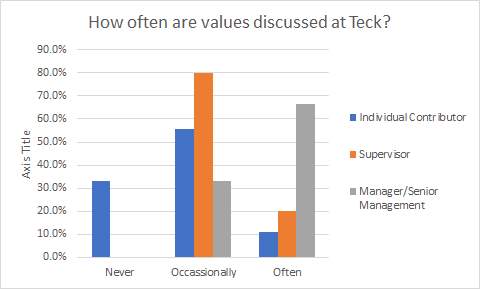
Figure 1 – Discussion of Values
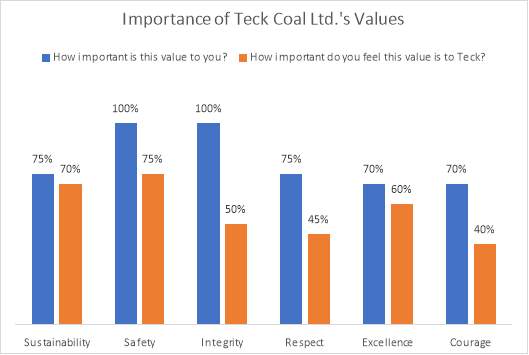
Figure 2 – Importance of Company Values

Figure 3 – Supervisor Feedback
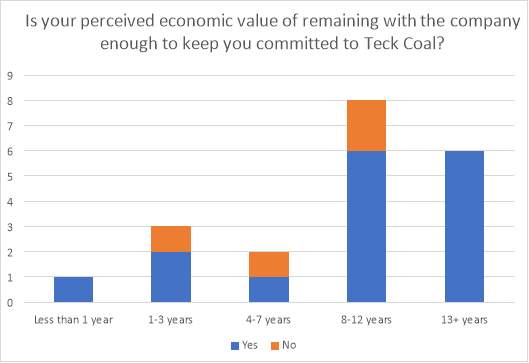
Figure 4 – Company Commitment: Monetary Value
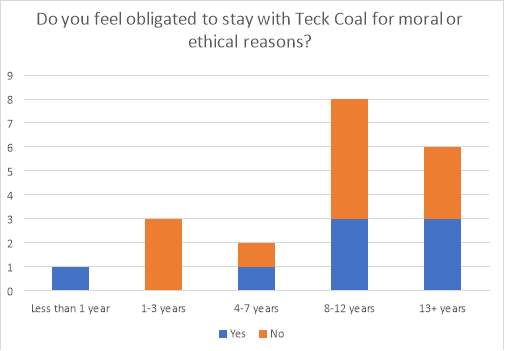
Figure 5 – Company Commitment: Moral or Ethical Reasons
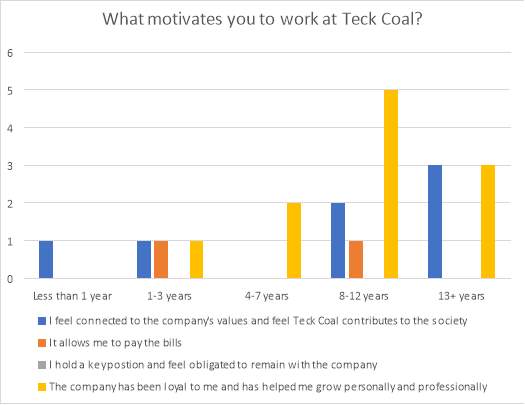
Figure 6 – Motivation to Work at Teck Coal Ltd.
Appendix A: Survey Questions
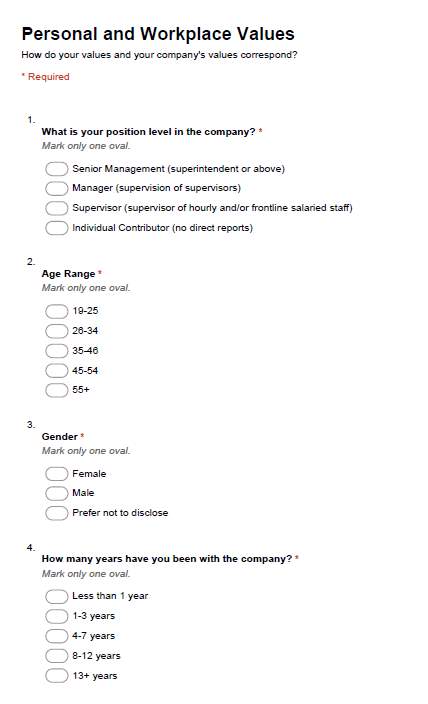
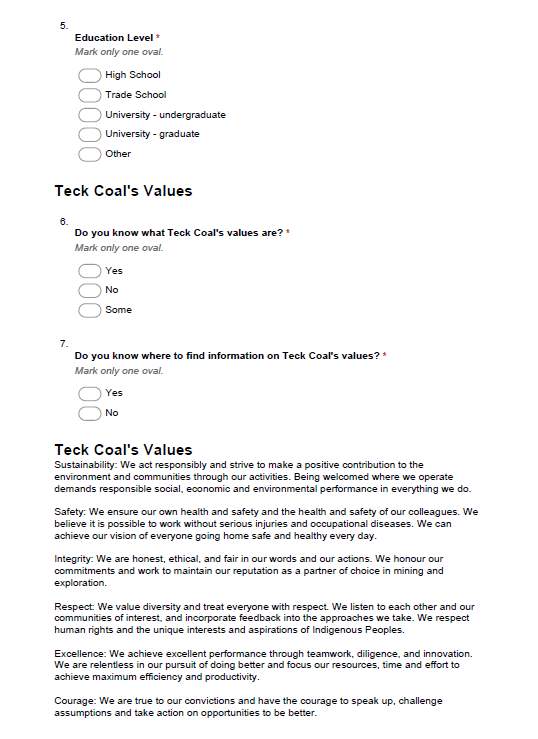
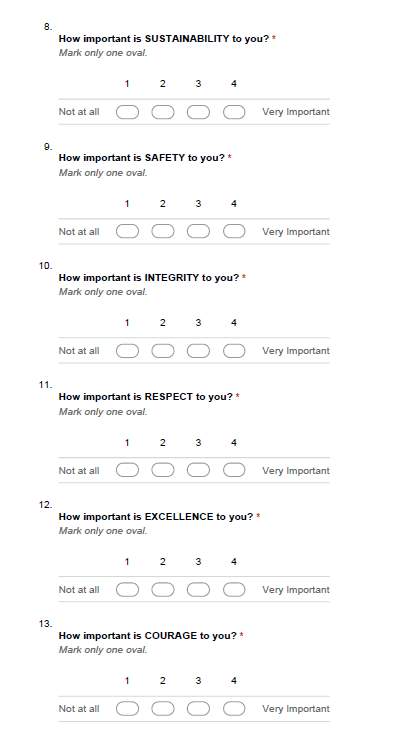
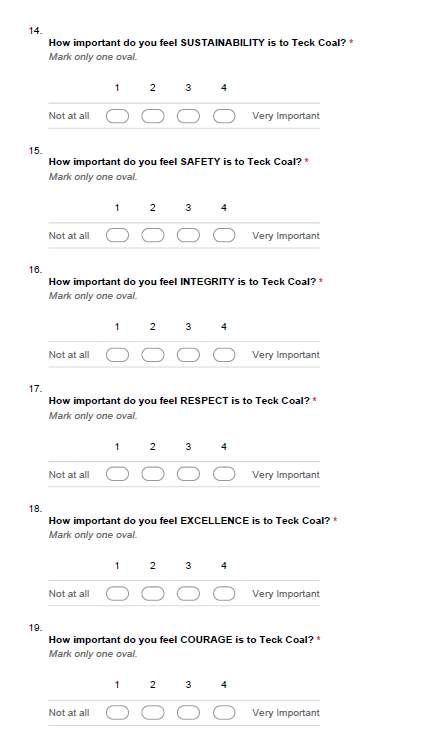
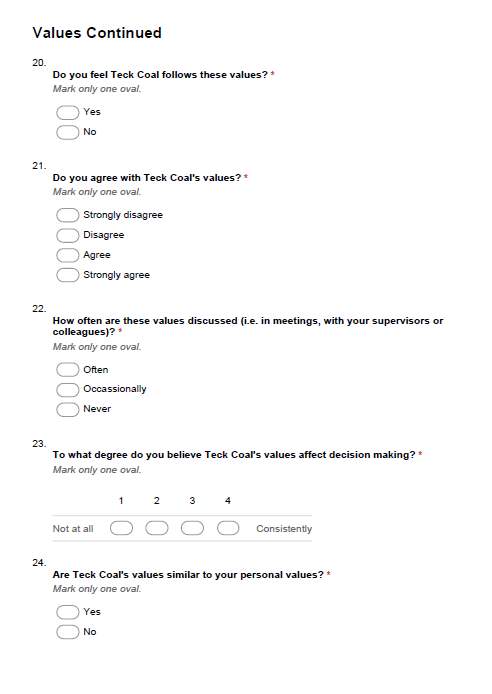
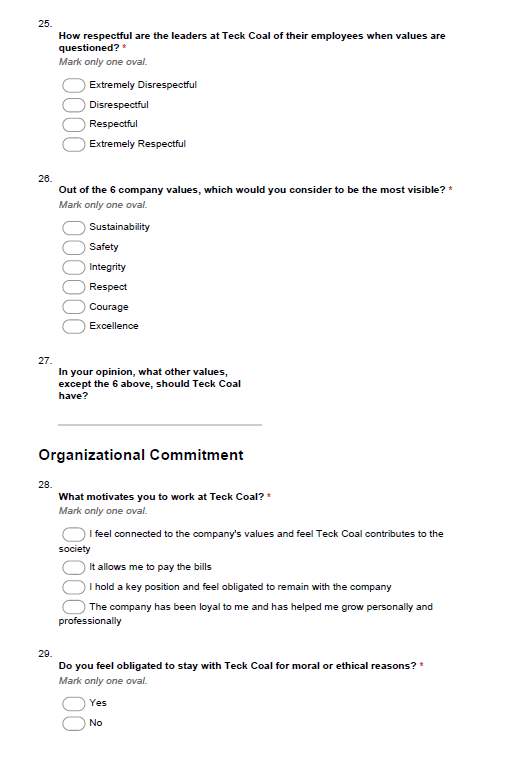
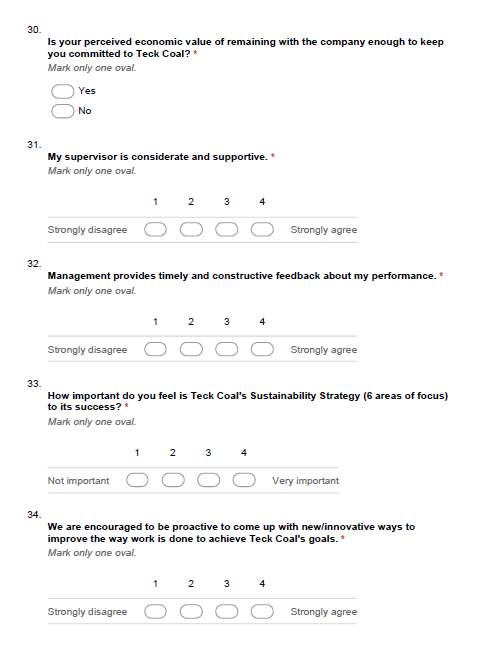
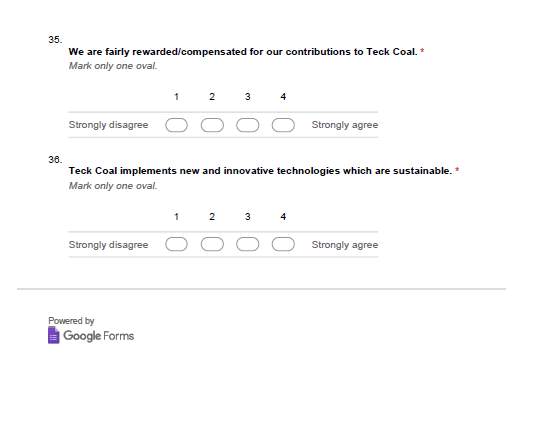
Appendix B: Survey Results
These are the general question results that were asked. The rest of the results are discussed in more details in the Results section of the report.
| What is your position level in the company? | Age Range | Gender | How many years have you been with the company? | Education Level | Do you know what Teck Coal’s values are? | Do you know where to find information on Teck Coal’s values? |
| Senior Management (superintendent or above) | 45-54 | Male | 13+ years | University – graduate | Yes | Yes |
| Manager (supervision of supervisors) | 35-46 | Male | 8-12 years | University – graduate | Yes | Yes |
| Manager (supervision of supervisors) | 26-34 | Male | 8-12 years | University – undergraduate | Yes | Yes |
| Supervisor (supervisor of hourly and/or frontline salaried staff) | 45-54 | Male | 13+ years | High School | Yes | Yes |
| Supervisor (supervisor of hourly and/or frontline salaried staff) | 35-46 | Male | 13+ years | Trade School | Yes | Yes |
| Individual Contributor (no direct reports) | 26-34 | Male | 1-3 years | University – undergraduate | Some | Yes |
| Supervisor (supervisor of hourly and/or frontline salaried staff) | 26-34 | Female | 8-12 years | High School | Yes | Yes |
| Individual Contributor (no direct reports) | 26-34 | Male | 1-3 years | University – undergraduate | Yes | Yes |
| Individual Contributor (no direct reports) | 35-46 | Male | 8-12 years | Other | Yes | Yes |
| Individual Contributor (no direct reports) | 26-34 | Male | 8-12 years | University – undergraduate | Yes | Yes |
| Individual Contributor (no direct reports) | 26-34 | Female | 4-7 years | High School | Yes | Yes |
| Supervisor (supervisor of hourly and/or frontline salaried staff) | 26-34 | Female | 8-12 years | University – undergraduate | Yes | Yes |
| Individual Contributor (no direct reports) | 26-34 | Female | Less than 1 year | University – undergraduate | Yes | Yes |
| Individual Contributor (no direct reports) | 26-34 | Female | 4-7 years | University – graduate | Yes | No |
| Manager (supervision of supervisors) | 35-46 | Male | 13+ years | High School | Yes | Yes |
| Senior Management (superintendent or above) | 35-46 | Male | 8-12 years | University – graduate | Yes | Yes |
| Individual Contributor (no direct reports) | 26-34 | Female | 8-12 years | Other | Some | No |
| Manager (supervision of supervisors) | 55+ | Male | 13+ years | High School | Yes | Yes |
| Supervisor (supervisor of hourly and/or frontline salaried staff) | 35-46 | Male | 13+ years | High School | Yes | Yes |
| Individual Contributor (no direct reports) | 26-34 | Male | 1-3 years | University – undergraduate | Yes | Yes |
Cite This Work
To export a reference to this article please select a referencing stye below:
Related Services
View allRelated Content
All TagsContent relating to: "Management"
Management involves being responsible for directing others and making decisions on behalf of a company or organisation. Managers will have a number of resources at their disposal, of which they can use where they feel necessary to help people or a company to achieve their goals.
Related Articles
DMCA / Removal Request
If you are the original writer of this dissertation and no longer wish to have your work published on the UKDiss.com website then please:




